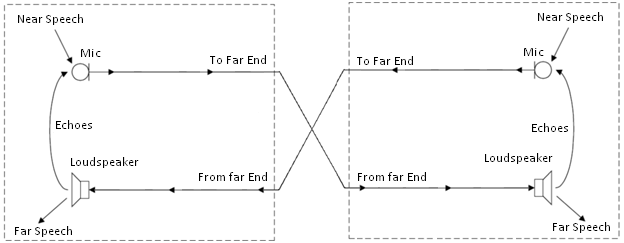Conferencing Basics
The following diagram shows a very basic conference application with communication between two rooms:

If you implement the above example with half-duplex there is no echo because audio only goes one way at a time and there is no echo return path. Half-duplex is problematic as it does not allow a normal conversation to take place. Most conferencing applications prefer duplex operation and often require it since this provides communication in both directions at all times, allowing far more natural communication.
The problem with duplex communication without AEC is that it can result in echo at one or both ends of the conference. This occurs when a near-end microphone picks up far-end audio from the overhead loudspeaker and returns a delayed signal to the far-end, which is then sent back to the near-end. This delayed feedback causes an echo that can impede intelligibility and/or make a system unstable. The type of connection between the far-end and near-end determines the length of the delay, which may be from several milliseconds up to a couple hundred milliseconds.
It is possible to reduce echo by carefully selecting room acoustics, microphone type and placement, loudspeaker type and location and volume levels. Even when these elements of a design are optimal, it is not possible to fully eliminate echo without the use of active acoustic echo cancellation. However, paying close attention to these elements of design improves the performance of any system with or without AEC. We refer to echo reduction achieved through acoustic, microphone and loudspeaker choices as Echo Return Loss (ERL), which indicates the reduction in echo before AEC is applied. The higher this reduction, the better the system will perform with AEC.